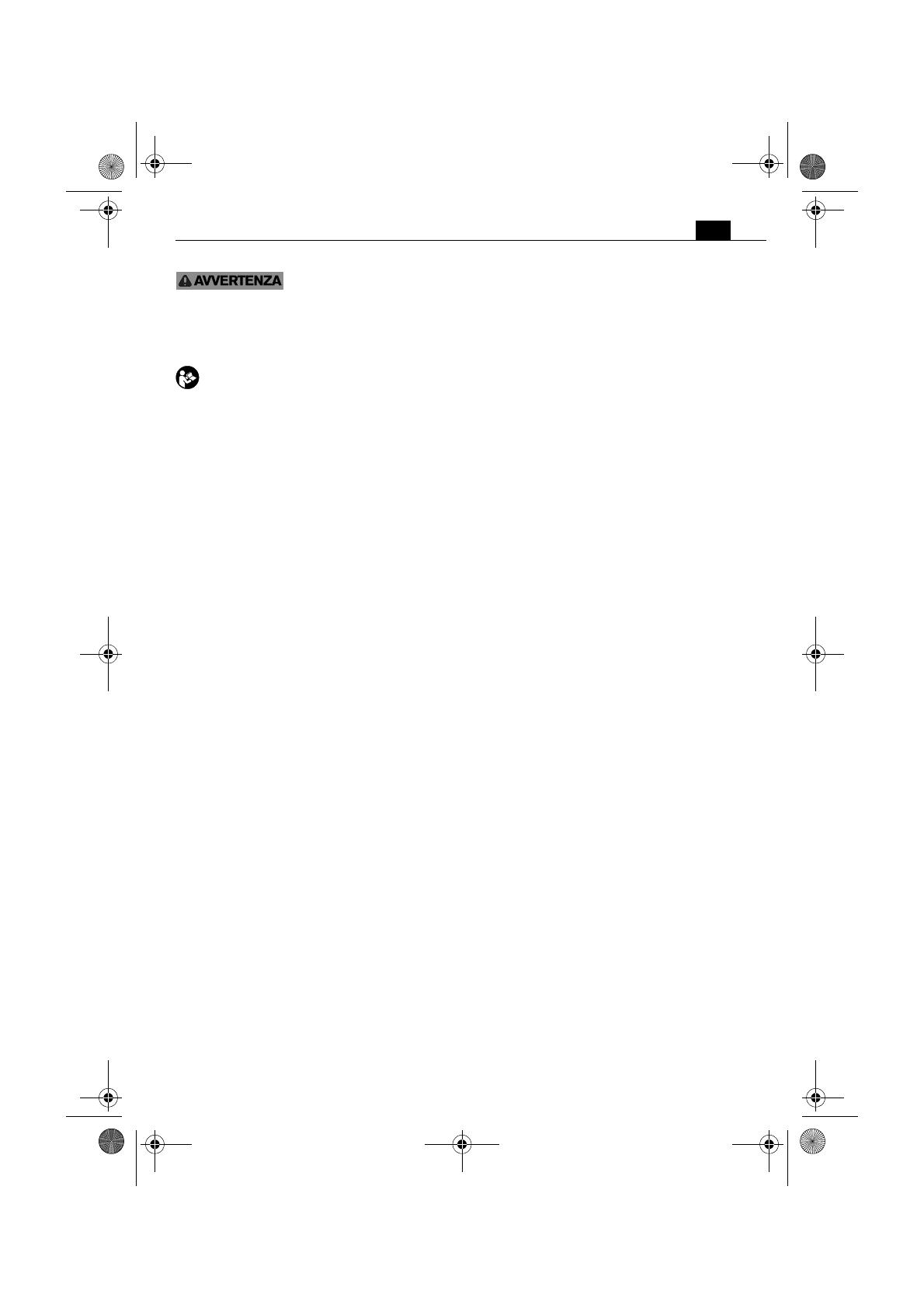
19
it
Per la Vostra sicurezza.
Leggere tutte le avvertenze di
pericolo e le istruzioni operative.
In caso di mancato rispetto delle avvertenze di pericolo e
delle istruzioni operative si potrà creare il pericolo di
scosse elettriche, incendi e/o incidenti gravi.
Conservare tutte le avvertenze di pericolo e le istruzioni
operative per ogni esigenza futura.
Non utilizzare il presente elettroutensile prima di
aver letto e compreso accuratamente e completa-
mente queste istruzioni per l’uso e le «Indicazioni
generali di sicurezza» allegate (numero di documenta-
zione 3 41 30 054 06 1). Conservare la documentazione
indicata per un eventuale uso futuro ed allegarla in caso
di inoltro oppure di vendita dell’elettroutensile.
Attenersi anche alle norme nazionali in vigore concer-
nenti la sicurezza sul lavoro.
Utilizzo previsto per l’elettroutensile:
smerigliatrice per l’utilizzo manuale per levigatura a secco
con carta vetrata di superfici di metallo, pietra, plastica,
legno, materiali compositi, pitture/vernici, stucco e mate-
riali simili con inserti ed accessori consigliati dalla FEIN in
ambiente protetto dagli agenti atmosferici.
Norme speciali di sicurezza.
Indossare abbigliamento di protezione. A seconda
dell’applicazione in corso utilizzare una visiera completa,
maschera di protezione per gli occhi oppure occhiali di
sicurezza. Per quanto necessario, portare maschere per
polveri, protezione acustica, guanti di protezione oppure
un grembiule speciale in grado di proteggervi da piccole-
particelle di levigatura o di materiale. Gli occhi dovreb-
bero essere protetti da corpi estranei espulsi in aria nel
corso di diverse applicazioni. La maschera antipolvere e la
maschera respiratoria devono essere in grado di filtrare la
polvere provocata durante l’applicazione. Esponendosi
per lungo tempo ad un rumore troppo forte vi è il peri-
colo di perdere l’udito.
Assicurare il pezzo in lavorazione. Un pezzo in lavora-
zione tenuto fermo con un dispositivo di bloccaggio è più
sicuro che se tenuto con la semplice mano.
Impugnare saldamente l’elettroutensile. Possono verifi-
carsi brevemente elevati momenti di reazione.
È vietato applicare targhette e marchi sull’elettroutensile
avvitandoli oppure fissandoli tramite rivetti. In caso di
danno dell’isolamento viene a mancare ogni protezione
contro scosse elettriche. Utilizzare targhette autoadesive.
Non utilizzare nessun tipo di accessorio che non sia stato
appositamente sviluppato oppure esplicitamente appro-
vato dalla casa costruttrice dell’elettroutensile. Un fun-
zionamento sicuro non è assicurato dal semplice fatto che
le misure di un accessorio combacino con il Vostro elet-
troutensile.
Pulire regolarmente le fessure di ventilazione dell’elet-
troutensile con attrezzi non metallici. La ventola del
motore attira polvere nella carcassa. Questo può causare,
in caso di accumulo eccessivo di polvere metallica, peri-
coli elettrici.
Prima della messa in funzione controllare il cavo di colle-
gamento alla rete e la spina di rete in caso di danneggia-
menti.
Raccomandazione: Far funzionare sempre l’elettrouten-
sile tramite un interruttore di sicurezza per correnti di
guasto (RCD) con valutazione corrente di guasto di 30 mA
oppure inferiore.
Modo di procedere con polveri pericolose
Nelle procedure operative di asporto materiale con il
presente utensile si formano polveri che possono essere
pericolose.
Il contatto oppure l’inalazione di alcune polveri p. es. di
amianto e materiali contenenti amianto, vernici conte-
nenti piombo, metallo, alcuni tipi di legno, minerali, par-
ticelle di silicato di materiali contenenti minerali, solventi
per vernici, sostanze protettive per legno, vernice antive-
getativa per imbarcazioni possono causare reazioni aller-
giche e/o malattie delle vie respiratorie, cancro, danni
riproduttivi alle persone. Il rischio dovuto all’inalazione di
polveri dipende dall’esposizione. Utilizzare un’aspira-
zione adatta alla polvere che si forma nonché equipaggia-
menti protettivi personali e provvedere per una buona
aerazione del posto di lavoro. Lasciare effettuare la lavo-
razione di materiale contenente amianto esclusivamente
a personale specializzato.
Polvere di legname e polvere di metallo leggero, miscele
bollenti da polvere di levigatura e sostanze chimiche pos-
sono, in caso di condizioni sfavorevoli, prendere fuoco o
causare un’esplosione. Evitare la fuga di scintille in dire-
zione del contenitore per la polvere nonché il sovrariscal-
damento dell’elettroutensile e del materiale abrasivo,
svuotare per tempo il contenitore per la polvere, osser-
vare le istruzioni di lavorazione del produttore del mate-
riale e le norme valide nel Vostro paese relativamente ai
materiali da lavorare.
Vibrazione mano-braccio
Il livello di oscillazioni indicato nelle presenti istruzioni è
stato misurato conformemente ad una procedura di
misurazione normalizzata contenuta nel EN 60745 e può
essere impiegato per la comparazione con altri elettrou-
tensili. Lo stesso è adatto anche per una valutazione tem-
poranea della sollecitazione da vibrazioni.
Il livello di oscillazioni indicato rappresenta le applicazioni
principali dell’elettroutensile. Se tuttavia l’elettroutensile
viene utilizzato per altri impieghi, con accessori differenti
oppure non viene effettuata una sufficiente manuten-
zione è possibile che il livello di oscillazioni sia differente.
Questo può aumentare sensibilmente la sollecitazione da
vibrazioni per l’intero periodo di lavoro.
Per la precisa valutazione della sollecitazione da vibra-
zioni dovrebbero essere considerati anche i tempi in cui
l’apparecchio è spento oppure è acceso ma non effettiva-
mente in funzione. Questo può ridurre considerevol-
mente la sollecitazione da vibrazioni per l’intero periodo
di lavoro.
Stabilire ulteriori misure di sicurezza per la protezione
dell’operatore dall’azione delle vibrazioni, come ad
esempio: manutenzione dell’elettroutensile e degli acces-
sori, mantenimento mani calde, organizzazione delle pro-
cedure operative.
OBJ_BUCH-0000000017-001.book Page 19 Friday, March 11, 2011 11:15 AM




















